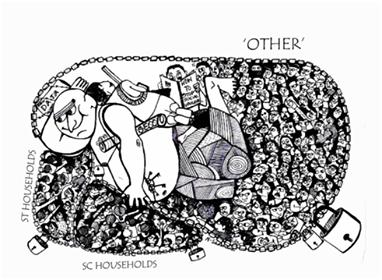Tejaswini Tabhane
I once wittily remarked that I am an economist till the time you do not ask me what will be the GDP projection for the next quarter. This remark does not merely come from my dislike of macroeconomics as a subject, but for the overemphasis, these few numbers get over the socio-political realities of the oppressed who fill the fuel in the engine for the growth of these numbers. Here, it is an attempt to present two different economic logics from two supposedly opposite spectrums of Indian politics. I would try to show how the interests of these two logics converge as they essentially represent the interests of the same castes and class in Indian society.

What the ‘Fascists’ dictate
Recently, the Ministry of Home Affairs issued a “standard operating system for the movement of stranded workers”. According to which the migrant workers, residing in relief camps, should register with the local authorities, and their skill-mapping be carried out to find out their suitability for various kinds of work. “In the event, migrants wish to return to their place of work, within the state where they are presently located, they would be screened, and those asymptomatic would be transported to their respective places of work,” the guidelines said. These guidelines came to effect from 20th April and look up to restarting the economic activities in the areas designated as containment zones1. The logic is that production should not come to a halt during the lockdown, and the economy should suffer as little as possible.
The ‘Anti-Fascists’ Critique
I vividly remember, the arguments made by some of the prominent academicians’ cum activists and the ‘well-read’ politicians2 during the national movement against the Citizenship Amendment Act (CAA) and promulgation of the exercise of All-India National Register for Citizens (NCR). Essentially, it was said that the Modi Government is stretching all this to ‘divert the attention of masses from the deteriorating state of the economy’ as the GDP numbers were continuously showing the downward trends. The arguments viewed as guiding notes as that we all should not get trapped in this and should keep talking about the ‘real issues’ and that is again, the Indian economy is in trouble. Previously, they also called abrogation of Article 377, as a ‘diversion’ to the economic problems. For these arguments, it seems that ‘economic logic’ prevails over the ‘political’ and ‘social logic’. The same line of arguments has mostly been followed during the NDA II tenure.
Countering this Economic logic
No one wishes to deny the fact that the economy was and still is, in trouble. However, to call a systematic attack by the state on the Muslim community a diversion cannot be justified by merely claiming ignorance to the realities of the crimes committed by the Indian state till date. And hence to understand the class interest, it is important to note who the forebears of these arguments are. Aren’t they the ones whose interest lie in the un-interrupted working of the economy, for they belong to the Brahmin-Savarna capitalist class?
They say the state is working, hand in glove with the capital. But shouldn’t they be asked that if indeed that is the case, why the state then must not work to revive the economy in the interest of the capital rather than trying to ‘divert’ people’s attention from it by establishing mechanisms to further their oppression? Does the Brahmanical conscience of the state not have political, social and imperialist interests? Do these interests not converge with that of the voices, who draw the above line of argument and hence, they do not want the marginalized to assert their politics and to not fight for even the basic rights such that of equal citizenship which is denied to them? Isn’t this a testimony to what Babasaheb wrote about the priestly brahmins and the secular brahmins working together to safeguard their class interest?
Another question that should be asked is who has to talk about the economy? The Bhadralok Brahmin led groups of economists, of course! (Please recall the names of economists you know in India, and you will agree that I am not exaggerating the fact). They will be the ones conducting seminars on how to revive the economy at their big centres where the ‘real’ issues are discussed. Then what should the ‘Bahujans’ do? Continue to speed the wheel of production and hence their exploitation to feed the profit-hungry bellies of Brahmin-Baniya capitalists and the (over) consumption of Savarna-middle class.
According to the paper, entitled ‘Wealth Inequality, Class and Caste in India, 1961-2012’ which was published in November 2018, the annual consumption of a Brahmin Household was estimated to be Rs. 146,037 and that of the Upper Caste Household was Rs. 143,497 which are almost double than that for Scheduled Tribe Household which had an estimated consumption of Rs. 72,732. The consumption of Scheduled Caste Household was around Rs. 87,985 whereas that of OBCs was Rs. 108,722.3
This data has to be studied keeping in mind that Bahujans constitute no less than 80 per cent of the population and they form the major part of the working class, also are engaged in the mass consumption for the elites in the country. The economists want to talk about the real issue of reviving the economy as the size of the pie is increasing at a relatively slower pace without first addressing the highly skewed distribution of resources and the distributional consequences arising out of this inequality.
The state of an economy is not only what the GDP figures tell us. The state of the economy is also how the people pushed at the margins are coping. Unfortunately, in India, the majority of people are pushed at the margins, and the elite minority occupy the mainstream. And to think about the margins is not the part of the mainstream discourse of economics in India. This discourse starts with GDP and ends with GDP. As if, increasing the national income would miraculously make everyone better off. That’s the fallacy of this discourse.
Another fallacy is to think that to work on the margins is for the development economists to do. And how have they approached this? Mostly by following the much-celebrated method of looking at the issue of poverty and inequality through a much more ‘multidimensional’ concept of ‘capability deprivation’ as proposed by Amartya Sen. What Kuffir, in his article4 said about the untold part when we use the term privilege is sufficient enough to counter the above approach if we can read privilege as capability. He writes:
If privilege is interpreted as ‘unearned advantage’, it tells you only half the story. The untold part is that this unearned advantage was gained through expropriating concrete assets from those who ‘lack privilege’. That the underprivileged paid for the unearned advantage. The discourse of privileges converts this antagonistic relationship into one of inequality. This has two insidious purposes. One, it places both groups, who are antagonists in reality, on one ground, thus introducing the suggestion that they’re equal participants, and the only difference between them being one of degree: one is taller, another is shorter, one went to an elite school, while the other went to a government school and so on. All differences become relative differences. Two, it places the burden of bridging this inequality on the Bahujan, which by now seems like a very logical, natural solution if you fall in line with this train of discourse. She has to improve herself, reform herself, and work harder to reach the level of the Brahmin-Savarna.
The higher GDP projection would mostly mean the higher rate of exploitation for the Bahujan working class. So why should the Bahujans take the burden of this economy? Why should they care about the rate of growth of a system that is based on their exploitation? I do not wish to leave an impression that the economy in trouble would mean something better for the Bahujans; for they will be the first ones to lose their livelihoods in such a situation as the economic structure has systems in place to always safeguard the class interest of Brahmin-Savarnas. This is just to clearly state the fact that it is not in the interest of the Bahujans to take the burden to fight for employment unless the dignity of labour is assured and to resist privatisation unless the public sector ensures justice and proportional representation and the Brahmin-state stop promoting state-led capitalism under the garb of state socialism. And the Bahujans shall not talk about economy unless the premise is set to have a radical transformation of the existing caste structure — on which the political economy of India is based on — and to strive for a society which Babasaheb envisioned when he wrote this5:
“In a society where there is exemption from restraint, a secured release from obstruction, in a society where every man is entitled not only to the means of being, but also of well-being, where no man is forced to labour so that another may abound in luxuries, where no man is deprived of his right to cultivate his faculties and powers so that there may be no competition with the favoured, where there is emphasis of reward, where there is goodwill towards all…”
Thanks to Dnyanesh whose insights were helpful in articulating this article and to Sidra for her suggestions.
~
Notes
1. MHA allows movement of stranded migrant workers, students, tourists and pilgrims with conditions
2. Govt is diverting people’s attention from economic woes: Atishi Marlena
Chidambaram: CAA a ploy to divert attention from economy
3. Income inequality in India: Top 10% upper caste households own 60% wealths
4. Bahujans and Brahmins: Why their realities shall always collide, not converge
5. Dr. BabasahebAmbedkar Writings and Speeches, Volume 12 Pg. 735 https://www.mea.gov.in/Images/attach/amb/Volume_12.pdf
~~~
Tejaswini Tabhane is an undergraduate student of Economics at Miranda House, University of Delhi.










